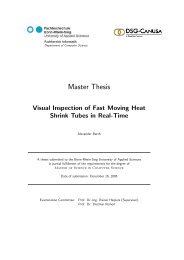Master Thesis - Hochschule Bonn-Rhein-Sieg
Master Thesis - Hochschule Bonn-Rhein-Sieg
Master Thesis - Hochschule Bonn-Rhein-Sieg
You also want an ePaper? Increase the reach of your titles
YUMPU automatically turns print PDFs into web optimized ePapers that Google loves.
7. Conclusion and Outlook <strong>Master</strong> <strong>Thesis</strong> Björn Ostermann page 115 of 126<br />
7 Conclusion and Outlook<br />
7.1 Conclusion<br />
This work shows new ways towards a collaborative workplace, using a 3D camera and a PC program,<br />
to allow an industrial robot and humans to work alongside each other.<br />
Two approaches towards this goal have been implemented in the course of the project. The first is a<br />
speed control based on proximity monitoring. The second is a path planning algorithm that plans a<br />
collision free trajectory of the robot arm, based on the location of dynamic objects, the position of the<br />
robot and its goal.<br />
The resulting demonstrator, programmed during the course of this work, uses both approaches<br />
separately, demonstrating their functionality. The developed workplace has been successfully<br />
demonstrated during presentations at the BGIA and has proven to function reliably. While still tasks<br />
remain for further studies (see chapter 7.2), the stability of the system was seldom disturbed by outside<br />
influences. Only two specific pieces of clothing (a grey jeans and a black shirt) proved to be<br />
problematic to the developed algorithm because of their unexpected values from the 3D camera’s<br />
measurement.<br />
Due to a problem in the external control mode of the robot, which is caused by the robot’s PLC, the<br />
robot tends to judder if goal changes occur in the direct drive mode. This has no influences on the<br />
functionality but only in the smoothness of the path execution in this mode.<br />
The algorithms, the PC and the sensor equipment used in the demonstrative workplace have not been<br />
designed towards the necessary safety, but have only been implemented for this case study. The safety<br />
of the system at this stage is ensured by the application of a hold to run button.<br />
If the complete project is implemented for industrial purpose and both approaches are combined, only<br />
the control of the robot’s speed needs to be safe. The trajectory will only allow the robot to use its full<br />
potential. The advantage of this approach, other than the reduced demand on the safety of the planning<br />
of the trajectory, is that the algorithm of the trajectory planning can be changed afterwards without<br />
reevaluation of the safety of the whole system.<br />
As chapter 6.3 showed, the system is not ready for industrial application at this point. In chapter 6.5 a<br />
conclusion was formulated from the observed performances, resulting in the observation that the<br />
designed system, implemented in special hardware, could be used to control a robot at 2 m/sec with a<br />
safety distance of 500 mm.














